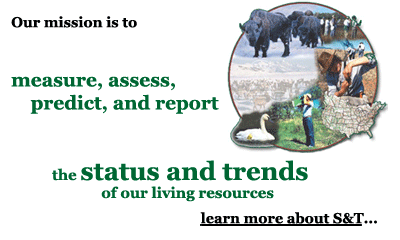- Home
- About S&T
- Taxa/Organisms
- Ecosystems
- Issues
- Methods & Tools
- Reports & Publications
- Location
- Search
 Status & Trends Home
Status & Trends Home
Program Relevance The Nation’s living resources and the habitats on which they depend are undergoing constant change. Climate change, invasive species, and a plethora of human activities are causing natural resource management and conservation efforts to become increasingly challenging and complex. To help meet this challenge, USGS’s Status and Trends of Biological Resources Program supports and provides the collection and analysis of biological data for use by natural resource managers, scientists, and the general public.
The Nation’s living resources and the habitats on which they depend are undergoing constant change. Climate change, invasive species, and a plethora of human activities are causing natural resource management and conservation efforts to become increasingly challenging and complex. To help meet this challenge, USGS’s Status and Trends of Biological Resources Program supports and provides the collection and analysis of biological data for use by natural resource managers, scientists, and the general public.
 To protect and conserve the living resources entrusted to their care, land and resource managers must first understand the condition, or status, of those resources:
To protect and conserve the living resources entrusted to their care, land and resource managers must first understand the condition, or status, of those resources:
• inventory (what they are), • distribution (where they are located), • abundance (how many there are), • productivity (their capacity to produce), • health (their well-being, resilience) and then understand the trends being exhibited by those resources • variables change over time and space. Visit our Program Overview Learn more about the USGS Status & Trends Program; including our goals. page to learn more. |
Events
5/13/2009 - 5/15/2009
-
11th Annual Southeast EPPC Conference
6/16/2009 - 6/17/2009
-
World Ocean Council's Sustainable Ocean Summit
9/29/2009 - 10/4/2009
-
Raptor Research Foundation 2009 Annual Conference
Did You Know...?
Post-Fire Treatment Impacts on Fine Fuels in Westside Sierra Nevada Forests
FeatureSouth Central ARMI: Guide to Louisiana Amphibians The U.S. Geological Survey's Amphibian Research and Monitoring Initiative (ARMI) has developed the following pages as a guide to the amphibian species of Louisiana as part of a monitoring effort for amphibians. The guide contains descriptions of each species along with a range map and pictures of the species when available. Check the glossary for an explanation of the terms used in these descriptions. Go to the South Central ARMI page to access the guide. Projects
We monitor our nation's living resources to understand changes in animal and plant habitats. Visit our Methods and Tools page for more information.
|
||||||||
|
|||||||||
Publications
|